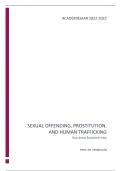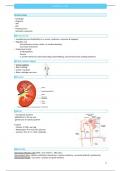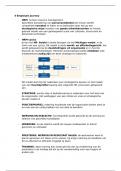ACADEMIEJAAR 2022-2023
SEXUAL OFFENDING, PROSTITUTION,
AND HUMAN TRAFFICKING
VOLLEDIGE SAMENVATTING
PROF. DR. VERMEULEN
,SOPHT 2023
SEXUAL OFFENDING, PROSTITUTION, AND
HUMAN TRAFFICKING: INTRODUCTION
AIM & PHENOMENA SELECTED
Aim
To gain a proper, nuanced and multi-perspective understanding of the causes, mechanisms, dynamics and complexity of a
cluster of specific (crime) phenomena, i.e. sexual offending, prostitution and human trafficking, as well as of their interrelations
and of societal and (criminal) policy reactions thereto
_ Idea: safe space to discuss issues with each other
g He’s going to offer different perspectives on different subjects (his own and others with arguments)
_ If we know the phenomena instead of judging people/situations from a distance based on largely moral perspectives,
it will be better. It helps to study issues relating to sex work for instance.
g If we are not willing to look further into it and know the evidence base for such claims, because it is limited,
it wouldn’t help to study the problems that sex workers have in different countries
g Evidence = causes, mechanisms, push and pull factors etc.
_ We have to do preparatory reading for the classes
issues (phenomena) selected | modules
- trafficking in human beings
g legal approaches and policies | phenomenon and dynamics
- prostitution
g legal approaches and policies | phenomenon and dynamics
- child sexual abuse & abuse of power or authority
- sexual exploitation of children, CSAM/CSEM & grooming
- rape, sexual assault & sexual harassment
- bestiality & animal porn, BDSM & necrophilia
- pornography, exhibitionism voyeurism
- AI & robots
PERSPECTIVES & DIMENSIONS
The course is mixed:
- legal dimension
g domestic, European, international and comparative criminal, administrative/immigration, social and
extraterritorial jurisdiction law
g The law is the way to shape the political reality that we want. It is about the options that the law takes that
we will discuss. Often the law isn’t fine the way it is so we need to be able to see and discuss that.
- prevention strategies and societal and (criminal) policy reactions
- phenomenological and epidemiological data
- different perspectives:
g victim perspective
• not in all the parts because there isn’t always a victim
g offender perspective
g children’s rights perspective
• in the modules dealing directly with sexual abuse and exploitation of children but also in the context
of sex work for instance (minors above 16 years old)
1
,SOPHT 2023
- different dimensions:
g moral dimension: sexuality morality and attitudes
g economic dimension: demand and supply (elasticity) in the sexual services market, …
• sex work module: the escort branch – intrepeneurship
• trafficking module: push and pull factors (looking for cheap labor and some are offering it)
g corporate dimension: corporate and chain responsibility, sectoral self-regulation
• It’s not only about natural persons and individuals
• Chain responsibility matters!
g gender and gay dimensions
- migration perspective: international and EU third country national migration, free movement EU
- European and international policy level and actor perspective
g EU (Council, EC, EP, Europol, etc.), Council of Europe, OSCE, ILO, UN
g Typically it is UNàCoEàEU
g This course is not offering national perspectives! No linkage with Belgian law except when we are a good
example in history
- multi-actor perspective
g Police, labour and social inspection services, prosecution services, immigration services, border guards, tax
administrations, city administrations, neighbourhoods, NGO’s, health and welfare sector
EXPECTATIONS (COMPETENCES)
- understand/unveil the interaction between legal/regulatory frameworks and evaluative, normative and attitudinal
frameworks/discourses regarding sexuality, sexual behavior and exploitation
- independently consult, analyse and critically/scientifically assess sources, literature and research data
- apply knowledge of the European and international institutional and policy development context of criminology and
criminal justice when addressing sexual offending, prostitution and human trafficking and reactions thereto
- address sexual offending, prostitution and human trafficking multi-dimensionally, multi-disciplinary, through multiple
(theoretical) frames and from a multi-actor perspective
- apply in-depth knowledge of the phenomena concerned (and reactions thereto) in scientific research
- understand and analyse current debates and issues regarding sexual offending, prostitution and human trafficking
crime (and reactions thereto)
- critically approach sexual offending, prostitution and human trafficking (and reactions thereto) through research and
the application of theory
- articulate a scientifically-reasoned opinion about sexual offending, prostitution and human trafficking (and reactions
thereto) that pays due attention to ethical, cultural and legal issues
- think independently and critically about societal and (criminal) policy reactions to the phenomena of sexual offending,
prostitution and human trafficking
- write a clear report on the results of (own) scientific research and/or personal views
- respect cultural differences, pluralism, gender and ethical standards
You need to have an opinion BUT it needs to be underpinned! Even if he disagrees, if the arguments and underpinning is fine
you get the points.
2
, SOPHT 2023
TEACHING METHODS
- integration seminar
g building on and aiming at integrating knowledge that was acquired during a range of courses
g (limited) introduction to the topic and literature
g enabling for/focused on group discussion
- guided self-study
g course materials organized per module
g mandatory readings [ahead of live sessions]
• Do not study them but read them so you can get the point they’re making and you can discuss them
in class
g optional readings as a courtesy (inspiration for papers, discretionary knowledge consolidation, broadening &
deepening)
- self-reliant study activities
g research: individual or group (4 students max) paper
g 3000 words/person, excluding footnotes and reference list or bibliography
EVALUATION
- periodic (50%)
g this year: written exam with short-answer questions and open questions, balancing legal and non-legal
questions
g open questions envisage testing students’ understanding and analytical and interpretational skills regarding
the causes, mechanisms, dynamics, complexity and interrelations of the phenomena concerned and
regarding societal and (criminal) policy reactions thereto
g see sample questions
• In may he is going through it with us
g legal instruments for use during exam: bespoke reader
g non-annotated bilingual translation dictionary allowed
- non-periodic (50%)
g research paper | separate information session
- participation in both non-periodic and periodic evaluation is mandatory
g otherwise, students will be declared “failed”, meaning that if the final score is ten or more (out of twenty),
this score will be reduced to the highest non-pass grade
g when you send him an email you can take the exam/paper in first sit and transfer them to the second sit
when you take the other part.
3






